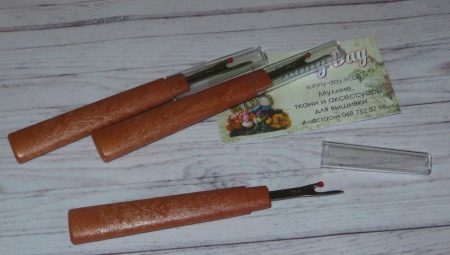What is a de-ripper and how to use it?

Everyone, both professional seamstresses and beginners in the sewing business, has been able to unpick failed or unnecessary stitches on the fabric. For this reason, in the arsenal of every experienced dressmaker there should be a special tool - a ripper, which is a metal needle with a base. It can be used to quickly and neatly rip up any seam, remove unnecessary thread, undo a button or cut a buttonhole.

Description and types
In Soviet times, an ordinary razor blade was used more often, which was both dangerous and ineffective. The blade can always cut too far into the fabric. It is good that now such a tool as a sewing machine either comes with other accessories for sewing machines, or can be purchased at any store with sewing accessories. An invaluable device in many cases.

The seam ripper has an unusual shape, which is great for removing threads without damaging the fabric structure. This tool has two ends: one pointed inside, with a tip, and one blunt. Such a structure allows you to cling to any thread in any inaccessible places, and the fabric, as a result, looks almost intact.
The tip has two tips, one of which is a very sharp blade, like a scalpel, it should not bend or change shape during operation. It is with its help that you can effectively pick up the threads. The second small tip has a protective ball, with which you can pierce the fabric in the places where the buttonholes will be made, and then use the middle of the blade in order to make small cuts in the fabric.

The handle of the seam ripper cannot be too slippery, it must have a comfortable rough surface, and lie comfortably in the seamstress's hand when working.
Different manufacturers can produce tools of different sizes and materials. There are two main types of separators in terms of size: standard and enlarged. Large attachments are more often used to rip open seams with larger, denser threads for sewing. This type of ripper is used to work with dense and heavy things (coats, jackets, jeans). Its length is about 15 centimeters. And the standard ones are designed to remove seams with thinner threads on lighter things (shirts, T-shirts, dresses).


This sewing tool usually comes with a cap. When the sewing attachment itself is not in use, the cap must engage properly to prevent possible damage to the tool tip. There are also tools for unstitching, which are used for embroidery work.
They are used when there are many stitches to be removed with great care. In this case, you should work with great care. Otherwise, you can damage what should not be.

How to use it correctly?
Before starting work, you need to determine the density of the fabric of the garment and the strength of the stitches. And depending on this, choose a tool. Good lighting is also very important for work. Because the blade point is very well sharpened, it is best to keep it out of the reach of children.
To unravel a stitched seam, first, preferably from the wrong side of the seam, cut every third stitch in a row. The bobbin thread will be cut and the second thread can be simply pulled out.

On seams that are not too strong with long stitches, you can cut each stitch at a distance of 3 to 5 cm to speed up the process. It will be necessary to pull the thread and in those places where it begins to shrink, cut it.
In order to make an incision, you need to position the tip of the tool under the stitch. And with a light movement, cut the seam thread. When removing the seams around the loops from the overlock, you need to go from the edges of the loops to their middle.


It is very convenient to cut through the loops with a ripper, but in order not to accidentally cut the loops through and through, you can place a limiter needle at the end of the loops.
Care Tips
This sewing accessory requires that it be used only for its intended purpose, exclusively for sewing work. The blade must always be clean. To keep it sharp for a long time, you need to clean it after use. Since dirt can contribute to oxidation of the sharp cutting edge, the blade will tear the threads rather than cut them. This process will take a lot of effort to remove unnecessary stitches.


In order to avoid mechanical damage to the tip and not to injure yourself, it is best to always put a special cap on it when the instrument is idle. It must be stored in places where moisture or other substances cannot get. You can lubricate it with machine oil from time to time to avoid rusting.

The blade can become dull over time with use, even with the most careful care. Working with it may become impossible. In order not to damage the fabric, it is recommended to sharpen the ripper. In order to sharpen it in case of extreme urgency, you can use improvised items: sandpaper, a metal sponge or a disposable nail file.
But in most cases, despite the many ways to sharpen the blade at home, it is undesirable to take on them yourself. Since there are several important nuances in this process. In addition, due to inability, you can simply damage the blade.Therefore, it is best to replace a blunt tool with a new one or give it to a skilled specialist for sharpening, who can save it with the help of special knowledge and specially provided equipment.


Novice dressmakers may not know about this tool, but experienced seamstresses cannot do without it, since it is simply irreplaceable in many sewing jobs.
See below for what a de-ripper is and how to use it.








